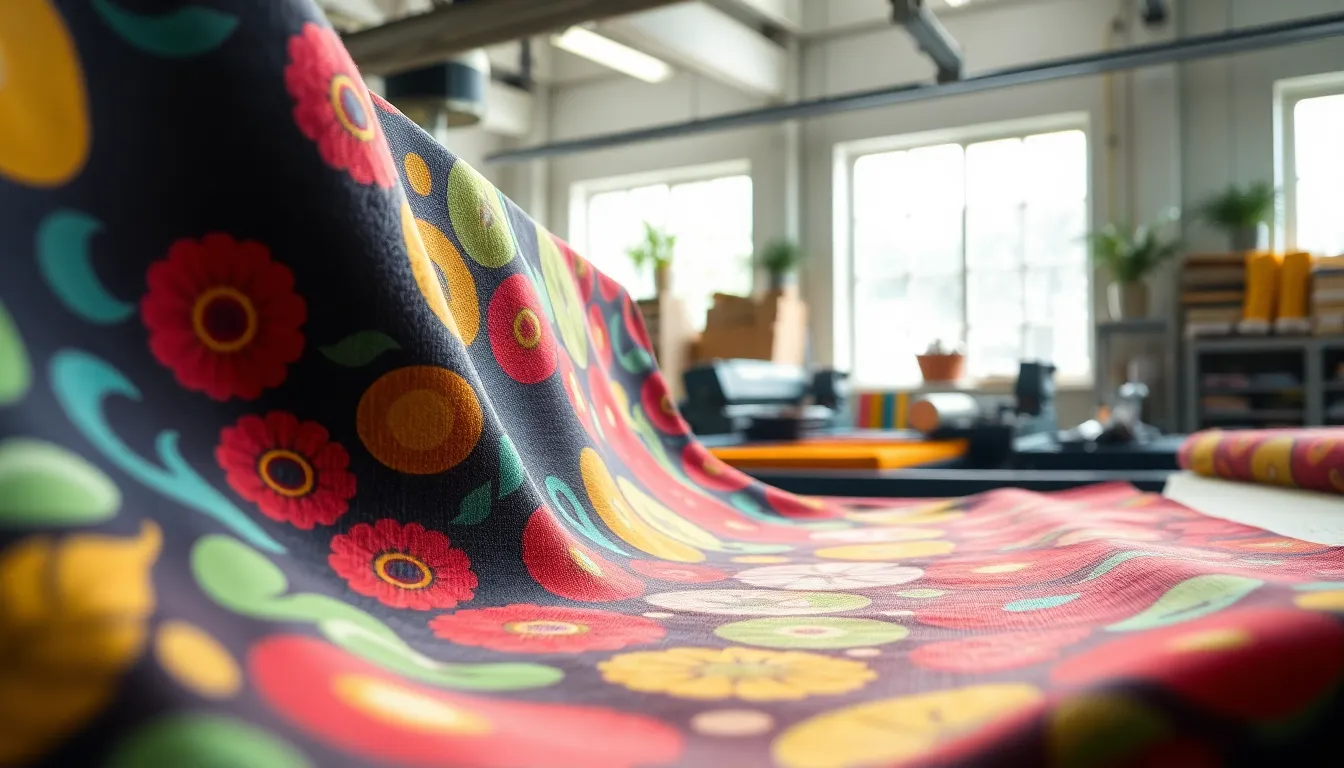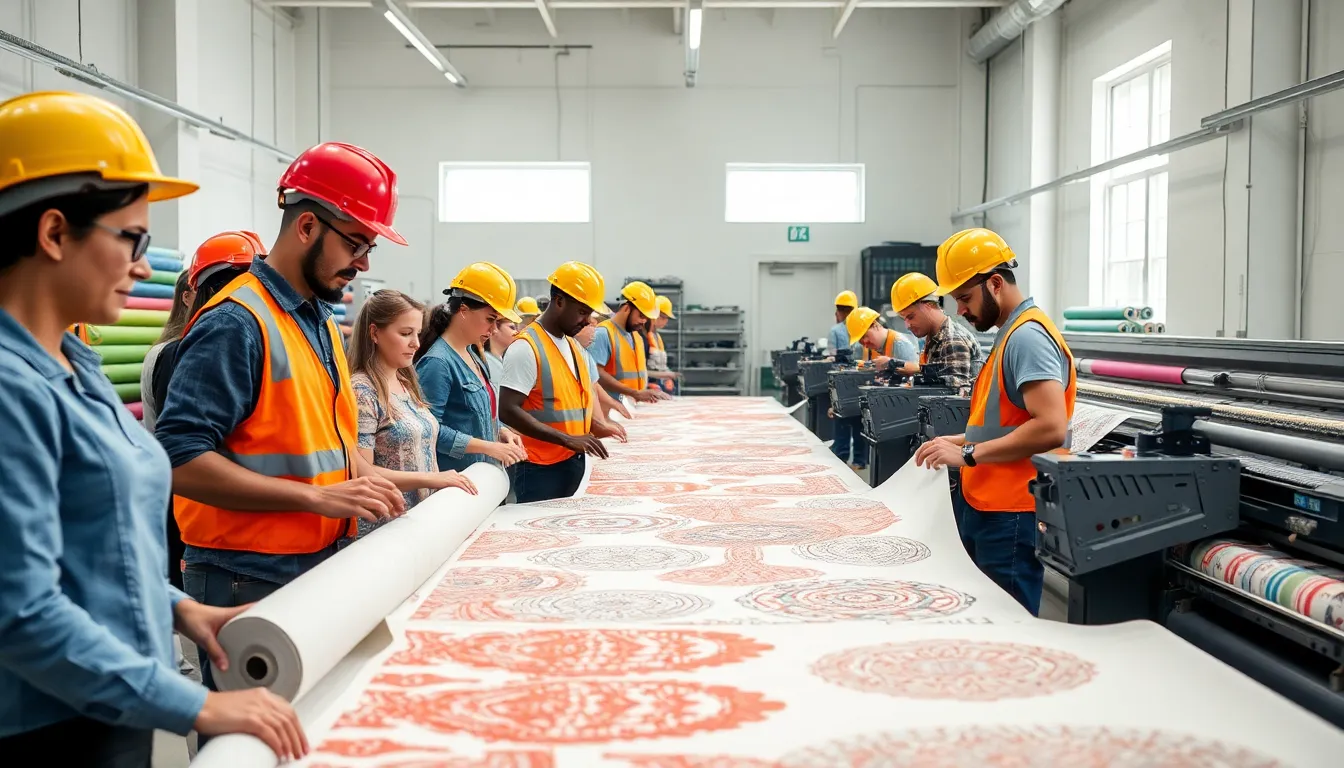In a world where fast fashion reigns supreme, sustainable fabric printing technology is the superhero we didn’t know we needed. Imagine a way to print vibrant designs on fabrics without harming the planet—sounds like magic, right? Well, it’s not just a fairy tale. This innovative technology is transforming the textile industry, making it possible to create stunning patterns while keeping Mother Earth happy.
Table of Contents
ToggleOverview of Sustainable Fabric Printing Technology
Sustainable fabric printing technology represents a significant shift in textile manufacturing. Methods such as digital printing reduce water usage and chemical waste compared to traditional screen printing. Innovations in ink formulations, including water-based and biodegradable options, further minimize environmental impact.
Digital fabric printing stands out for its efficiency. This technique enables manufacturers to create intricate patterns quickly and with less waste. Industries adopting this technology report a decrease in production time, which allows for a faster response to changing consumer demands.
Waste reduction remains a primary focus. Many sustainable printing processes emphasize zero-waste designs and upcycling materials. By utilizing eco-friendly substrates, such as organic cotton and recycled polyester, companies align with circular economy principles.
Energy efficiency is another crucial aspect. Advanced machinery in sustainable printing often consumes less energy, helping to lower carbon emissions. Organizations that implement these technologies demonstrate a commitment to reducing their ecological footprint.
Consumer demand influences the growth of this sector. Shoppers increasingly prioritize environmentally responsible products, prompting brands to seek sustainable solutions. Collaborations between raw material suppliers and technology innovators enable the development of more efficient printing methods.
Sustainable certification programs also play a role in shaping the industry. Standards such as OEKO-TEX and GOTS provide guidelines for environmentally friendly practices. These certifications assure consumers that products meet high sustainability criteria, promoting transparency.
Overall, sustainable fabric printing technology offers a viable alternative to conventional methods, driving positive change in the textile industry. This approach fosters a balance between aesthetic design and environmental responsibility, fulfilling the needs of both consumers and the planet.
Advantages of Sustainable Fabric Printing

Sustainable fabric printing technology brings numerous benefits that impact both the environment and the economy.
Environmental Benefits
Sustainable fabric printing significantly reduces water consumption compared to traditional methods. Many processes use between 30-50% less water, making a substantial difference in water-scarce regions. Chemical usage decreases as well, with eco-friendly inks often being water-based or biodegradable. These innovations minimize pollutant release into waterways, enhancing ecosystem health. Waste management improves due to zero-waste designs, which incorporate leftover fabric into new products. This practice supports a circular economy by diverting waste from landfills. Consumers benefit from products made with organic and recycled materials, promoting responsible consumption.
Economic Impact
Sustainable fabric printing technologies contribute to cost savings for manufacturers. Reduced water and energy usage lowers operational costs, enhancing profitability. Innovation in the industry leads to the creation of new jobs, as businesses invest in sustainable practices. The demand for eco-friendly products is increasing, prompting brands to target a growing consumer base that prioritizes sustainability. Brands adopting sustainable methods often differentiate themselves in the marketplace, thereby gaining a competitive edge. The positive economic impact reinforces the effectiveness of these technologies in meeting consumer expectations while supporting environmental goals.
Types of Sustainable Fabric Printing Technologies
Sustainable fabric printing technologies play a crucial role in reducing environmental impact. Several methods, each with unique benefits, contribute to a greener textile industry.
Digital Printing
Digital printing stands out for its efficiency and versatility. This technique allows intricate designs to be printed directly onto fabrics, minimizing waste. Compared to traditional printing methods, digital printing uses 30-50% less water and generates fewer chemical byproducts. The rapid production capabilities meet consumer demands swiftly, making it a preferred choice for many manufacturers. Brands can also easily adapt designs to align with market trends without excessive costs. Overall, digital printing offers an innovative solution that significantly lowers resource consumption while providing high-quality results.
Eco-Friendly Inks
Eco-friendly inks are essential for sustainable textile printing. These inks typically feature water-based or biodegradable formulations that minimize harmful chemical emissions. Choosing natural pigments and sustainable raw materials enhances color vibrancy without compromising eco-friendliness. Many manufacturers now prioritize inks certified by reputable organizations, ensuring they meet strict environmental standards. The reduction of toxic waste in the printing process improves health outcomes for workers and consumers alike. By adopting eco-friendly inks, companies can contribute to a more sustainable textile industry while captivating consumers seeking environmentally conscious products.
Challenges in Sustainable Fabric Printing
Sustainable fabric printing faces several challenges that hinder its widespread adoption. Understanding these challenges is essential for advancing technology and practices in the textile industry.
Cost Factors
Cost presents a substantial barrier in sustainable fabric printing. Initial investments in advanced machinery and eco-friendly inks can exceed traditional printing methods, leading to higher production costs. Brands often pass these costs onto consumers, limiting market reach. Additionally, smaller manufacturers may struggle to access sustainable materials due to higher prices and restricted supply chains. Affordability remains a crucial concern, especially in an industry driven by fast fashion, where low prices dominate.
Technological Limitations
Technological limitations affect the scalability of sustainable fabric printing. Current equipment may not support all types of fabrics or intricate designs, restricting creativity and versatility. Some eco-friendly inks lack color vibrancy compared to conventional options, impacting aesthetic appeal. Manufacturers frequently face challenges in achieving consistent print quality, especially on various textile substrates. Continuous innovation is vital, though transitioning to advanced technology might require substantial resources, presenting significant hurdles for broader implementation.
Future Trends in Sustainable Fabric Printing Technology
Continuous advancements in sustainable fabric printing technology shape the future of the textile industry. Brands increasingly prioritize eco-friendly practices, leading to innovations that enhance efficiency and reduce waste. Integration of artificial intelligence enables better design capabilities, optimizing production processes while minimizing environmental impact.
Emerging technologies focus on bio-based inks, further reducing reliance on harmful chemicals. Manufacturers are investing in closed-loop systems, which recycle water and materials, curbing waste and conserving resources. Circular economy principles encourage the reuse and upcycling of fabric scraps, promoting sustainability at every stage of production.
Consumer preferences influence market trends, pushing brands toward transparency and ethical sourcing. Adoption of smart textiles opens doors for interactive designs and functionality, appealing to tech-savvy shoppers. Investment in renewable energy sources for printing processes underlines the commitment to lowering carbon emissions.
Partnerships between material suppliers and tech innovators foster creation of sustainable solutions tailored to industry needs. Certification programs like OEKO-TEX and GOTS continue to gain traction, setting standards that ensure products meet environmentally responsible criteria. These initiatives bolster consumer trust while streamlining the certification process for brands.
Continuous monitoring of sustainability metrics drives accountability within the industry. As the push for eco-conscious practices grows, education surrounding sustainable printing technologies becomes crucial. Stakeholders increasingly seek collaborative platforms to share best practices, paving the way for a more sustainable future in fabric printing.
Sustainable fabric printing technology is reshaping the textile industry by marrying creativity with environmental responsibility. As brands increasingly adopt these innovative methods, they not only meet consumer demand for eco-friendly products but also contribute to a healthier planet. The emphasis on waste reduction energy efficiency and the use of biodegradable inks highlights a commitment to sustainability that resonates with today’s conscientious shoppers.
Looking ahead continuous advancements in technology will likely enhance the efficacy and accessibility of sustainable printing solutions. By fostering collaboration between manufacturers and tech innovators the industry can overcome current challenges and further promote environmentally friendly practices. The future of fabric printing is not just about aesthetics; it’s about creating a sustainable legacy for generations to come.

